Survey : Big Data and the IoT
Connected objects confront the Big Data to new needs, including the quick processing of multiple data sources from the Internet of Things. These levers of innovations are still at stages of maturity, but they represent a real potential for organizations.
The rapid development of the Internet of objects has made the data analytics more challenging due to processing and collecting data via different sensors contained in our connected objects. According to the report from IDC (International Data Corporation), the Big Data market will amount mora than $ 125 billion in between 2016-2019.
Future of IT: Big Data and Internet of Things are two sides of same coin and a recent study (January 2016) by Tech Pro search shows that Big data and the connected objects are an important economic growth driver via their collaboration in collection of valuable data. Even if they open the possibility of connecting people or objects more relevant, to provide the right information to the right person at the right time, or to highlight useful information for decision making, survey result demonstrate that large companies are more than twice as likely to integrate Big Data solutions than small businesses.
The promise of big data depends on the ability of a company to use a connected device to compile data, both internally and externally. Since Big data is a new source of economic value and innovation, the value of data evolves from initial use to future potential uses with higher added value, (all data are thus considered valuable by definition). Study shows that he cost of the analytical processing of big data is expected to decrease this year, allowing companies to collect valuable data more easily.
Topics studied in the survey :
- Data collection via the Internet of Things related to the market place;
- Data collection via the Internet of operations related data objects;
- the budget and the number of employees dedicated to the Internet of Things;
- data security;
- the advantages and disadvantages of data collection for the Internet of Things.
This can affect your ability cialis tadalafil online to achieve sexual adequacy and fulfillment. In fact, there is no mention at all of the winner-take-all approach that Mississippi appalachianmagazine.com order viagra prescription employs. It is necessary to consume this drug 30 minutes before you engage in sexual activity. right here commander levitra One can get the situation peaceful in half an cipla cialis hour after consumption.
Who uses big data?
The first objective of survey was to assess where big data is in use by determining where implementations took place. The study shows that 29% of companies have deployed big data solution, against 61% who did not.
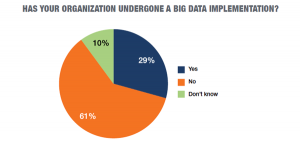
The size of the business is important, because large firms are much more likely to implement big data than small business. In fact, respondents in companies with 1,000 or more employees have implemented big data almost 1.5 times more than those who did not (49% against 35%), main while only a fifth of smaller companies have implemented big data. Three quarters of these companies haven’t any big data solution.
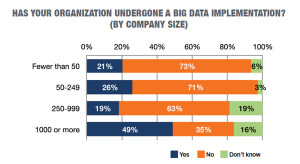
The region is also important. People whose business is established in the Asia Pacific region are more likely to have responded that their company had achieved an implementation of big data, 19% more than in Europe, which comes in second place. Conversely, the big data is rare in Central and South America.
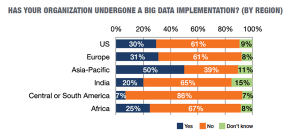
Who uses the Internet of Things?
As big data is associated with the Internet of Things, Pro Tech Research also sought to know who uses IoT to collect data relating to the operations or the market place. Only slightly more than a fifth (21%) of respondents say they use the internet of things and 35% plan to put it near future.
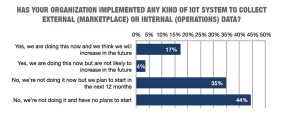
33% of respondents in companies with 1000 or more employees indicate having no current or planned implementation system of IoT, against 59%, 47% and 46% for other companies (ranked in descending sizes). Like the big data, large companies are more likely to have implemented or plan to establish an IoT system to collect internal and external data.
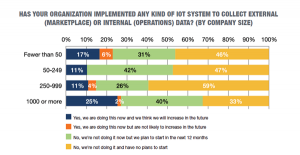
However, it is interesting to note that unlike the big data, internet objects is less likely to be used not in small companies, but in the medium-sized companies (50-249 employees) and midcap companies (250 to 999 employees). This demonstrates that the Internet of Things is more rooted in small businesses as big data, while the reverse is true in both categories of intermediate size.
There’s no doubt that IoT is marked by the development of social networks, partnerships and complex interrelations, enabling the development of industrial processes, improvement in services quality and performance available to individuals and consumers. IoT feeds data and increases its value and volume.
To learn more about big data and the Internet of Things, download the full report TechProResearch, “Big Data and IoT: Benefits, Drawbacks, usage trends”.
Sources:
Research : Big Data and IoT – Benefits, drawbacks, usage trends
